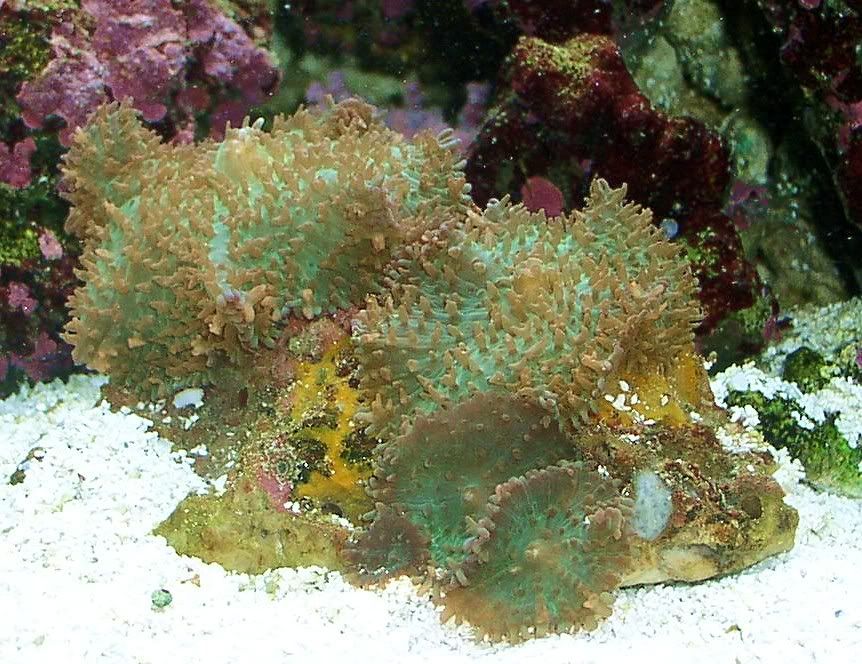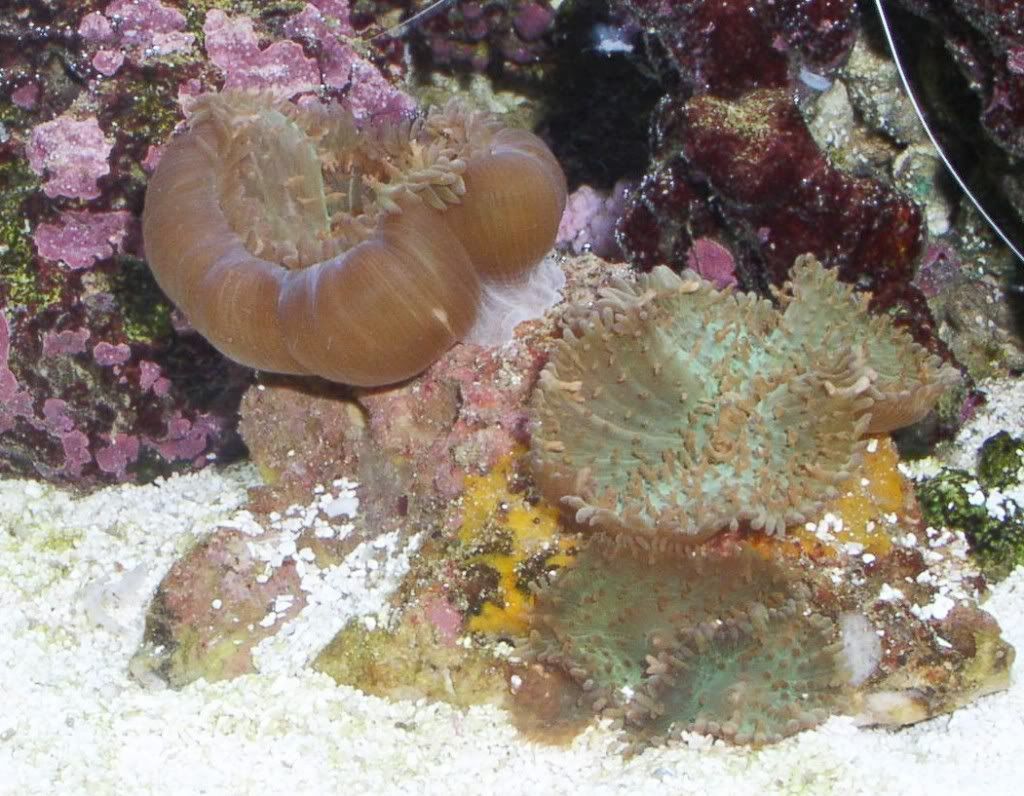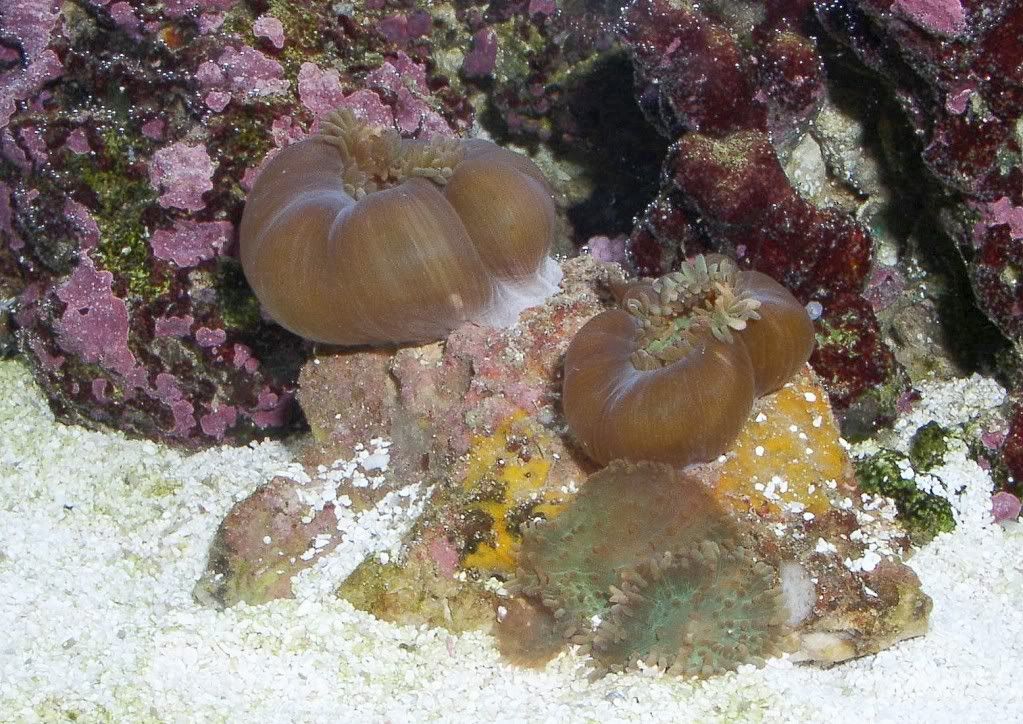Coral Heath
- Thread starter fishkid13
- Start date
fishkid13
Active Member
8:56 Lights just turned on
Attachment 228807
9:06
Attachment 228808
9:18
Attachment 228809
9:28

Attachment 228810
Attachment 228811






Attachment 228807
9:06
Attachment 228808
9:18
Attachment 228809
9:28

Attachment 228810
Attachment 228811






katsafados
Active Member
It could have closed up because of food falling onto it or something bothering it!
fishkid13
Active Member
Thanks.
9:28 More food. Clamy
Attachment 228812
9:48
Attachment 228813
9:52
Attachment 228814
 Enjoy and Ponder.
Enjoy and Ponder.




9:28 More food. Clamy
Attachment 228812
9:48
Attachment 228813
9:52
Attachment 228814





fishkid13
Active Member
Originally Posted by meowzer
http:///forum/post/3098653
My mushrooms change a lot during the course of the day....I think it's normal
How do your mushrooms "change"
http:///forum/post/3098653
My mushrooms change a lot during the course of the day....I think it's normal
How do your mushrooms "change"
big
Active Member
Not to steal the thread, but just to see the quickness of them, here is a eating sequence from years ago in my tank.....
When being directly feed they can close to eat what they have catch very quickly.. Only a few seconds, maybe 20 or so from the first shot to the last....
Ohhhh BTW Mushrooms are not true corals anyway...... Warren



When being directly feed they can close to eat what they have catch very quickly.. Only a few seconds, maybe 20 or so from the first shot to the last....
Ohhhh BTW Mushrooms are not true corals anyway...... Warren



flower
Well-Known Member

When I first got into the hobby...I noticed that when I fed the tank everything kind of closed up...I thought they didn't like the food..
When I asked my saltwater guru of that time, he told me corals feed by closing up a bit. It takes them a long time to feed, thats why it is so late in the day when they close a bit, unless you spot feed.
flower
Well-Known Member
Originally Posted by big
http:///forum/post/3099233
Not to steal the thread, but just to see the quickness of them, here is a eating sequence from years ago in my tank.....
When being directly feed they can close to eat what they have catch very quickly.. Only a few seconds, maybe 20 or so from the first shot to the last....
Ohhhh BTW Mushrooms are not true corals anyway...... Warren




I disagree...mushrooms are true corals, they are not true mushrooms, they just look like mushrooms, hense the name.
http:///forum/post/3099233
Not to steal the thread, but just to see the quickness of them, here is a eating sequence from years ago in my tank.....
When being directly feed they can close to eat what they have catch very quickly.. Only a few seconds, maybe 20 or so from the first shot to the last....
Ohhhh BTW Mushrooms are not true corals anyway...... Warren




I disagree...mushrooms are true corals, they are not true mushrooms, they just look like mushrooms, hense the name.
big
Active Member
Originally Posted by Flower
http:///forum/post/3099299

I disagree...mushrooms are true corals, they are not true mushrooms, they just look like mushrooms, hense the name.
Flower, I understand your need to call them corals.. And yes I tend to think of them that way too...... And today we all just refer to them that way..... I was just stating what I have read about the little buggers over the years.
The first little paper back book I ever got about trying a crack at this crazy obsession we all have was one published in the early days of modern reef keeping. I wish I could find it today. I think the book was the late 80,s early 90,s.......
This one of the first things I read about these guys was their placement in the coral family's. They did not fit.
This was the issues with where they where in the evolutionary chain.......Here is a quote from another source.
"Known as Mushroom or Disc Anemones, and Mushroom Corals, here is profile information on Order Corallimorpharians - Family Discosomatidae / Actinodiscidae species corals. Although considered to be halfway between anemones and stony corals, members in this family more closely resemble soft corals, and therefore are commonly grouped in this category.
In reading some of these types of literature this shows why I see a reluctance to call them true corals................. This categorization being "Although considered to be halfway between anemones and stony corals" Sort of puts them in a place just as closely related to a anemone as to a coral.
Most of us would not call call an Anemone a coral would he and these guys are just as closely related to them as they are what we call the true corals.....
http:///forum/post/3099299

I disagree...mushrooms are true corals, they are not true mushrooms, they just look like mushrooms, hense the name.
Flower, I understand your need to call them corals.. And yes I tend to think of them that way too...... And today we all just refer to them that way..... I was just stating what I have read about the little buggers over the years.
The first little paper back book I ever got about trying a crack at this crazy obsession we all have was one published in the early days of modern reef keeping. I wish I could find it today. I think the book was the late 80,s early 90,s.......
This one of the first things I read about these guys was their placement in the coral family's. They did not fit.
This was the issues with where they where in the evolutionary chain.......Here is a quote from another source.
"Known as Mushroom or Disc Anemones, and Mushroom Corals, here is profile information on Order Corallimorpharians - Family Discosomatidae / Actinodiscidae species corals. Although considered to be halfway between anemones and stony corals, members in this family more closely resemble soft corals, and therefore are commonly grouped in this category.
In reading some of these types of literature this shows why I see a reluctance to call them true corals................. This categorization being "Although considered to be halfway between anemones and stony corals" Sort of puts them in a place just as closely related to a anemone as to a coral.
Most of us would not call call an Anemone a coral would he and these guys are just as closely related to them as they are what we call the true corals.....
flower
Well-Known Member
Originally Posted by big
http:///forum/post/3099323
Flower, I understand your need to call them corals.. And yes I tend to think of them that way too...... And today we all just refer to them that way..... I was just stating what I have read about the little buggers over the years.
The first little paper back book I ever got about trying a crack at this crazy obsession we all have was one published in the early days of modern reef keeping. I wish I could find it today. I think the book was the late 80,s early 90,s.......
This one of the first things I read about these guys was their placement in the coral family's. They did not fit.
This was the issues with where they where in the evolutionary chain.......Here is a quote from another source.
"Known as Mushroom or Disc Anemones, and Mushroom Corals, here is profile information on Order Corallimorpharians - Family Discosomatidae / Actinodiscidae species corals. Although considered to be halfway between anemones and stony corals, members in this family more closely resemble soft corals, and therefore are commonly grouped in this category.
In reading some of these types of literature this shows why I see a reluctance to call them true corals................. This categorization being "Although considered to be halfway between anemones and stony corals" Sort of puts them in a place just as closely related to a anemone as to a coral.
Most of us would not call call an Anemone a coral would he and these guys are just as closely related to them as they are what we call the true corals.....

Interesting...my books calls them corals, with no reference to anemones...the only one I would, but not my books... even remotely call related to the anemone would be the plate coral, which is considered a mushroom...since it moves and goes where it wants to.
I think what your book was referring to is the little colonies that live inside coral like the Xenia...the little colonies make up the whole coral. While a mushroom coral is a colony all to itself instead of being a part of a collective, LIKE an anemone, however not related to them.
I see no reference at all that they are an "in-between"...do you have an article where I could read up on this on line?
http:///forum/post/3099323
Flower, I understand your need to call them corals.. And yes I tend to think of them that way too...... And today we all just refer to them that way..... I was just stating what I have read about the little buggers over the years.
The first little paper back book I ever got about trying a crack at this crazy obsession we all have was one published in the early days of modern reef keeping. I wish I could find it today. I think the book was the late 80,s early 90,s.......
This one of the first things I read about these guys was their placement in the coral family's. They did not fit.
This was the issues with where they where in the evolutionary chain.......Here is a quote from another source.
"Known as Mushroom or Disc Anemones, and Mushroom Corals, here is profile information on Order Corallimorpharians - Family Discosomatidae / Actinodiscidae species corals. Although considered to be halfway between anemones and stony corals, members in this family more closely resemble soft corals, and therefore are commonly grouped in this category.
In reading some of these types of literature this shows why I see a reluctance to call them true corals................. This categorization being "Although considered to be halfway between anemones and stony corals" Sort of puts them in a place just as closely related to a anemone as to a coral.
Most of us would not call call an Anemone a coral would he and these guys are just as closely related to them as they are what we call the true corals.....

Interesting...my books calls them corals, with no reference to anemones...the only one I would, but not my books... even remotely call related to the anemone would be the plate coral, which is considered a mushroom...since it moves and goes where it wants to.
I think what your book was referring to is the little colonies that live inside coral like the Xenia...the little colonies make up the whole coral. While a mushroom coral is a colony all to itself instead of being a part of a collective, LIKE an anemone, however not related to them.
I see no reference at all that they are an "in-between"...do you have an article where I could read up on this on line?
big
Active Member
Well it is pouring down rain so I am back in drying off.

Here is one of many links that shows a description of my Mushrooms are truly "False Corals".... Apparently the proper name for a Mushroom is Mushroom Anemone , or false corals....
Entering the name False Corals in google will surprise many as to how many critters we all call corals , really are not corals, like GSP's Cloves, and more.. Look at the second link for shots of False Corals. The first on the list is our little Mushroom buddies......
Sorry Mods for the linking to another site........Warren
http://www.wetwebmedia.com/corallim.htm
http://www.jjphoto.dk/info_waterlife_polyps.htm

Here is one of many links that shows a description of my Mushrooms are truly "False Corals".... Apparently the proper name for a Mushroom is Mushroom Anemone , or false corals....
Entering the name False Corals in google will surprise many as to how many critters we all call corals , really are not corals, like GSP's Cloves, and more.. Look at the second link for shots of False Corals. The first on the list is our little Mushroom buddies......
Sorry Mods for the linking to another site........Warren
http://www.wetwebmedia.com/corallim.htm
http://www.jjphoto.dk/info_waterlife_polyps.htm
flower
Well-Known Member
Originally Posted by big
http:///forum/post/3099394
Well it is pouring down rain so I am back in drying off.

Here is one of many links that shows a description of my Mushrooms are truly "False Corals".... Apparently the proper name for a Mushroom is Mushroom Anemone , or false corals....
Entering the name False Corals in google will surprise many as to how many critters we all call corals , really are not corals, like GSP's Cloves, and more.. Look at the second link for shots of False Corals. The first on the list is our little Mushroom buddies......
Sorry Mods for the linking to another site........Warren
http://www.wetwebmedia.com/corallim.htm
http://www.jjphoto.dk/info_waterlife_polyps.htm
WOW!!! That is so interesting...so if I understood it right...if it doesn't have a skeleton it isn't a real coral??? That is just amazing, I learn so much from folks on this site...Thank you!
http:///forum/post/3099394
Well it is pouring down rain so I am back in drying off.

Here is one of many links that shows a description of my Mushrooms are truly "False Corals".... Apparently the proper name for a Mushroom is Mushroom Anemone , or false corals....
Entering the name False Corals in google will surprise many as to how many critters we all call corals , really are not corals, like GSP's Cloves, and more.. Look at the second link for shots of False Corals. The first on the list is our little Mushroom buddies......
Sorry Mods for the linking to another site........Warren
http://www.wetwebmedia.com/corallim.htm
http://www.jjphoto.dk/info_waterlife_polyps.htm
WOW!!! That is so interesting...so if I understood it right...if it doesn't have a skeleton it isn't a real coral??? That is just amazing, I learn so much from folks on this site...Thank you!
loopy101
Member
Originally Posted by Flower
http:///forum/post/3099329

Interesting...my books calls them corals, with no reference to anemones...the only one I would, but not my books... even remotely call related to the anemone would be the plate coral, which is considered a mushroom...since it moves and goes where it wants to.
I think what your book was referring to is the little colonies that live inside coral like the Xenia...the little colonies make up the whole coral. While a mushroom coral is a colony all to itself instead of being a part of a collective, LIKE an anemone, however not related to them.
I see no reference at all that they are an "in-between"...do you have an article where I could read up on this on line?
Hi Flower
 i know and understand shrooms werent considered corals. didnt relize that was everything with out a skeloton. but my question to you is about the plate coral. ive never heard of that being referenced to a mushroom since it has a skeloton just wondering if you could shed some light on that one to me?
i know and understand shrooms werent considered corals. didnt relize that was everything with out a skeloton. but my question to you is about the plate coral. ive never heard of that being referenced to a mushroom since it has a skeloton just wondering if you could shed some light on that one to me?
http:///forum/post/3099329

Interesting...my books calls them corals, with no reference to anemones...the only one I would, but not my books... even remotely call related to the anemone would be the plate coral, which is considered a mushroom...since it moves and goes where it wants to.
I think what your book was referring to is the little colonies that live inside coral like the Xenia...the little colonies make up the whole coral. While a mushroom coral is a colony all to itself instead of being a part of a collective, LIKE an anemone, however not related to them.
I see no reference at all that they are an "in-between"...do you have an article where I could read up on this on line?
Hi Flower

flower
Well-Known Member
Originally Posted by loopy101
http:///forum/post/3099942
Hi Flower
 i know and understand shrooms werent considered corals. didnt relize that was everything with out a skeloton. but my question to you is about the plate coral. ive never heard of that being referenced to a mushroom since it has a skeloton just wondering if you could shed some light on that one to me?
i know and understand shrooms werent considered corals. didnt relize that was everything with out a skeloton. but my question to you is about the plate coral. ive never heard of that being referenced to a mushroom since it has a skeloton just wondering if you could shed some light on that one to me?

Had nothing to do with anything I had read...it was just that plate coral moves where it wants to go...LIKE an anemone. If one were to compare a mushroom to an anemone, that made no sense to me...but a plate coral, now that had some possibilties. My coral book has plate coral listed as a mushroom.
 The only thing I know about them is that they move.
The only thing I know about them is that they move.
http:///forum/post/3099942
Hi Flower


Had nothing to do with anything I had read...it was just that plate coral moves where it wants to go...LIKE an anemone. If one were to compare a mushroom to an anemone, that made no sense to me...but a plate coral, now that had some possibilties. My coral book has plate coral listed as a mushroom.

